 Research Article
Research Article
Relationships Between the Physical Outputs of a Standardized 5v5 SSG Test Protocol and Maximal Match Outputs in Elite-Level Soccer
Adam Lee Owen1,2*, Matthew Newton3 and Nicola Luigi Bragazzi4
1Inter-university Laboratory of Human Movement Biology (EA 7424), Claude Bernard Lyon 1, France
2KKS Lech Poznań, Poznań, Poland
3Liverpool John Moores University (LJMU), Liverpool, United Kingdom
4Human Nutrition Unit (HNU), Department of Food and Drugs, Medical School, Parma, Italy
Adam Lee Owen, Inter-university Laboratory of Human Movement Biology (EA 7424), Claude Bernard Lyon 1, France and KKS Lech Poznań, Poznań, Poland
Received Date:January 23, 2024; Published Date:February 01, 2024
The aim of the present investigation was to quantitatively assess the association between 5v5 small, sided games (SSG) running and physiological performance during matches in order to ascertain the utility of SSG as a potential fitness test modality within elite professional soccer players. Twenty-three professional soccer players (mean ± SD; age: 25.3 ± 3.1 yr; mass: 76 ± 9 kg; height: 176 ± 9 cm) were recruited for the current investigation. Previous research had shown correlations with assessments of aerobic fitness (Yo-YoIR1). In the current study, players completed 5v5 SSG during the training period, wearing GPS and HR monitors. Overall, accelerations, decelerations, sum of accelerations and decelerations resulted in large correlation coefficients, both in terms of volume and intensity metrics. In terms of positional differences, accelerations, and decelerations in terms of volume metrics correlated between 5v5 SSG test outcomes and match outputs with large correlation coefficients in CB, and CM players. Coefficients were very large in WF players. The sum of accelerations and decelerations resulted in statistically significant correlations with large and very large coefficients in CM and WF players, respectively. Total distance correlated with a very large correlation coefficients in FB players. Similar trends could be reported in terms of intensity metrics. The present study has found that running performance during a standardized 5v5 SSG within elite soccer cohorts is associated with maximal match outputs, with the strength of correlation coefficients significantly varying according to playing positions. Soccer specific SSG could potentially supplement traditional testing methodologies.
Keywords:Training; SSG; YoYoIR1; GPS; HR
Introduction
The demands of soccer match-play are multi-factorial in nature and are constantly evolving over time. Research [1, 2] has shown that over the past ten years, the physical and technical demands of match-play have changed markedly, with significant increases in high intensity outputs, such as sprinting and high intensity running, and possession markers, such as total number of passes performed. Although soccer is generally reliant upon aerobic metabolism, players’ anaerobic capabilities and qualities have been shown to be key determinants of success in elite-level soccer [3, 4]. Faude et al.’s study [5] found that powerful actions such as sprinting, jumping and change of direction sprints preceded 83% of the goals scored in the first German national league.
These are key considerations to be taken into account when analyzing the key physical qualities of successful performance in elite-level soccer to ensure the training process is optimized [3, 4]. With this increased physiological and technical demand on elite-level soccer players, recent research [1, 2; 5-9] has expressed a need for training to replicate the demands of the game more closely. The use of Small Sided Games (SSGs) has been highlighted as an effective training method to develop physical fitness, technical ability and decision-making skills simultaneously, and therefore has become an indispensable component of the training process in elite-level soccer [5-10].
Additionally, SSGs are seen to be highly useful in the context of planning training sessions due to the nature of their flexibility and variability. Research [10,11] has shown that by manipulating specific external variables, the exercise intensity of the SSGs can be altered significantly. These variables include player numbers [12,13], pitch size [14,15], work to rest ratios [16], goal size [12], inclusion or exclusion of goalkeepers [17], game rules [14], coach encouragement [12], bout duration [17], training regime [18] and use of floaters [13]. As these factors have been shown to significantly impact the physiological and technical outcomes of SSGs, it is important that they are taken into consideration prior to implementing SSGs in training. As a result of the soccer specificity of SSGs, research [10,14,19,20] has explored the effects of specific SSG modalities on developing aerobic and soccer-specific endurance. Impellizzeri et al.’s study [19] found there to be no differences between generic running-based aerobic interval training modalities and the use of SSGs in the development of aerobic fitness, therefore arguing that SSGs may be a more advantageous mode of developing aerobic fitness in-season as it trains “aerobic fitness and tacticaltechnical components concurrently”.
Additionally, using soccer-specific alternatives to interval training has been shown to increase player motivation and buy-in, thus increasing player enjoyment [10,19]. The evidet associations between aerobic fitness development and the use of SSGs in teamsports, has led recent research [10,20] to explore the possibility developing SSG test protocol as an additional method to assess aerobic fitness changes in-season. Stevens et al. [20] utilized a 6v6 SSG protocol to assess the relationships between YoYo IR2 performance and running-based performance outputs in a 6v6 SSG. Authors found there to be a moderate-to-large correlation between key GPS metrics: total distance, high-speed running and high accelerations acquired from the 6v6 SSG protocol and running performance in the YoYo IR2 test, suggesting that SSGs could be used as an alternative method of assessing running performance in-season.
Additionally, Owen et al. [10] developed a standardized 5v5 SSG protocol, with the aim of assessing physiological and running performance in SSGs in relation to performance in the YoYo IR1 test. Owen et al.’s study [10] found there to be several moderate to very large associations between key performance markers such as, total distance and time above 85% of max heart rate (HR), in both assessments, suggesting that the 5v5 SSG protocol may provide practitioners with an effective and non-time-consuming method of assessing intermittent aerobic fitness in-season. Although SSGs have become a fundamental component in the training arsenal of elite-level soccer teams in recent years, little research [8,9,21] has investigated the demands of SSGs in relation to match-play, both from a team and positional perspective. Therefore, the present study was designed to fill in this gap of knowledge.
Materials and Methods
Experimental Approach to problem: Participants
The current investigation involved elite level soccer players within their domestic European competition with 80% of their team playing for respective national teams at the time of the study. The investigation involved data collected for 23 players (Mean ± SD, age: 25.3 ± 3.1 years; height: 183 ± 7 cm; mass: 72 ± 7 kg) during the in-season phase of the competitive season. The study was approved by the investigating institute’s ethics committee with written informed consent obtained from each player. The study period involved training sessions within the 2017/2018.
Small-Sided Game (5v5 Possession Game)
During the investigation period, the SSG (5 v 5 possession) consisted of free play with the focus of the SSG to maintain possession of the ball in a 5 v 5 method within a 25 x 25m grid resulting in a relative player area of 62.5-m2 (25x25/10 players). All SSG were performed under supervision and vocally encouraged by several coaches in order to keep the running performance of players high [14]. During all SSG free play was allowed with maximal touches, with multi-ball rule meaning replacement balls were quickly entered upon ball running out of play [10].
Before the study period, these SSG were frequently performed as part of the training methodology, so familiarity of the game type was substantial. All sessions were performed on the same natural grass turf pitch. In addition, all SSGs games were performed at the same time of the day (10 am-1 pm) to limit the effects of circadian variations on measured variables [10]. SSGs were preceded with a specific warm up of 15 min in duration. All SSGs for the assessment were standardized and composed of 3x3-min and a 2-min passive recovery between repetitions of the SSG [18].
Yo-Yo Intermittent Recovery Test Level 1
The Yo-YoIR1 involves 2 x 20-m shuttle runs at increasing speeds, interspersed with 10 seconds of active recovery between runs. The Yo-YoIR1 has previously within literature been reported as a way to assess player’s endurance intermittent aerobic capacity. This investigation was completed in line with procedures previously described by Owen et al. [10] and included participants completing a 15-minutes dynamic warm-up involving multi-joint and running activities of progressive intensity. Failure to complete a shuttle resulted in a verbal warning with participants being withdrawn on a second failure. Total distance achieved within the assessment and corresponding maximum speed at the final completed shuttle were recorded at the end of the test. Heart rate was measured at 1-s intervals during the test using the Polar Team 2 System (Polar Electro Oy, Kemple, Finland). Data from the system was then exported from the Polar software (Polar Team 2 Software, Kemple, Finland) to a data base (Microsoft Excel, Redmond, USA) for further analysis & statistical analysis. According to previous literature within this area, the YoYoIR1 test is shown as a valid and reliable assessment with the distance covered during a Yo-YoIR1 being directly related to match play running performance within soccer [21]. Furthermore, the Yo-YoIR1 is suggested to being sensitive to changes in fitness across acute training periods in team sports [21].
Running Performance Monitoring
During both the SSG testing intervention & competitive match play formats analyzed within this investigation, all individual running performances were monitored using a portable nondifferential 10-Hz GPS integrated with a 100-Hz, 3-dimensional accelerometer, 3-dimensional gyroscope, and a 3-dimensional digital compass (STAT Sports Viper, Northern Ireland). This type of system has previously been shown to provide valid and reliable estimates of instantaneous velocity during acceleration, deceleration, and constant-velocity movements during linear, multidirectional, and soccer-specific activities [16]. Each player was assigned a GPS vest that was tightly fitted. All devices were activated 15 minutes prior to data collection, match-play & training session commencement for acquisition of satellite signals. In addition, to avoid inter-unit error, each player wore the same GPS device for each training session.
After recording, the data was downloaded to a computer and analyzed using the software package Viper version (STAT Sports, Viper, System). Based on GPS data, total, high-speed (>19.8 km•h-1), sprint distance (>25.5 km•h-1); average metabolic power (W•Kg- 1); high metabolic power distance (m; ≥ 20 W•Kg-1); accelerations (n; ≥ 3.3 m•s-2); decelerations (n; ≥ -3.3 m•s-2) and dynamic stress load (AU) were calculated during each training session. Dynamic stress load represents the weighted total of all accelerometry above 2G based on convex curved G-force ratings. These measures are reflective of standardized measures of training load regularly reported within soccer cohorts.
Statistical Analysis
Descriptive and correlational analyses by means of the Pearson’s correlation (r) were used to assess the association between maximal match performance and selected 5v5 SSG test variables. Magnitude of the correlation (r) was considered trivial (< 0.1), small (> 0.1‒0.3), moderate (> 0.3‒0.5), large (> 0.5‒ 0.7), very large (> 0.7‒0.9), nearly perfect (> 0.9‒ 1.0), and perfect (1.0) according to the Hopkins’ rule of thumb. Analyses were performed using IBM SPSS Statistics for Windows (Version 22.0). All analyses were conducted with the statistical significance set at p-value < 0.05.
Results
Main characteristics of the 5v5 SSG test and match outcomes are reported in (Tables 1, 2) in terms of volume and intensity metrics.
Overall correlations are reported in (Table 3): accelerations, decelerations, sum of accelerations and decelerations resulted in large correlation coefficients, both in terms of volume and intensity metrics.
Main characteristics of the 5v5 SSG test outcomes and match performance in terms of volume and intensity metrics broken down to position are reported in (Tables 4, 5) respectively.
Accelerations and decelerations in terms of volume metrics correlated between 5v5 SSG test outcomes and match outputs with large correlation coefficients in CB, and CM players. Coefficients were very large in WF players. The sum of accelerations and decelerations resulted in statistically significant correlations with large and very large coefficients in CM and WF players, respectively. Total distance correlated with a very large correlation coefficients in FB players. Similar trends could be reported in terms of intensity metrics. Further details are shown in (Table 6).
Table 1:Main characteristics of the 5v5 SSG test outcomes in terms of volume and intensity metrics.
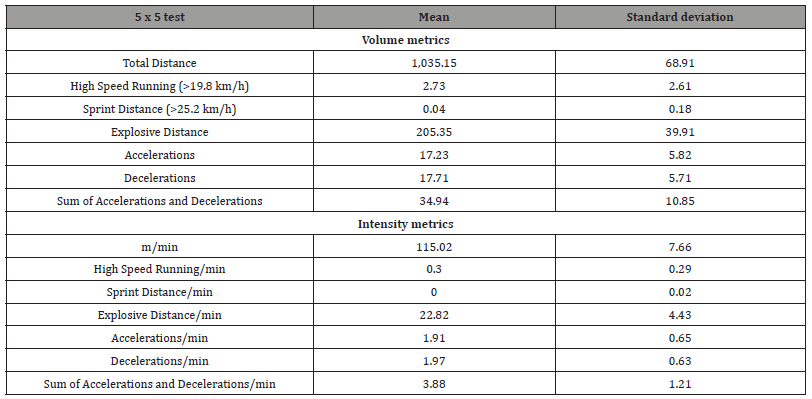
Table 2:Main characteristics of the match performance in terms of volume and intensity metrics.
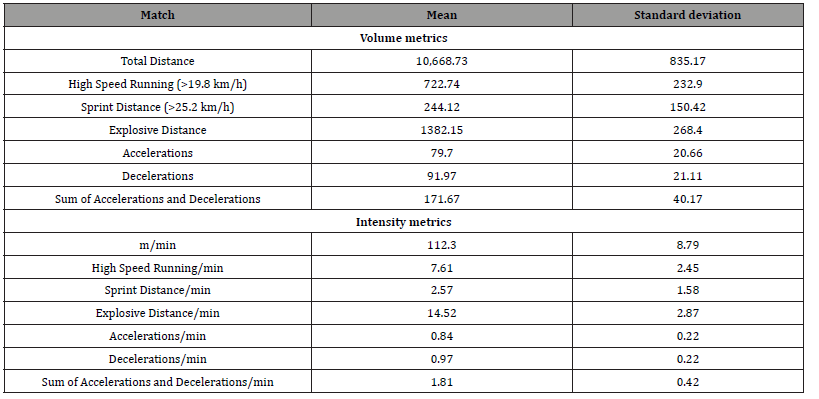
Table 3:Correlations between the 5 x 5 test and match characteristics in terms of volume metrics.
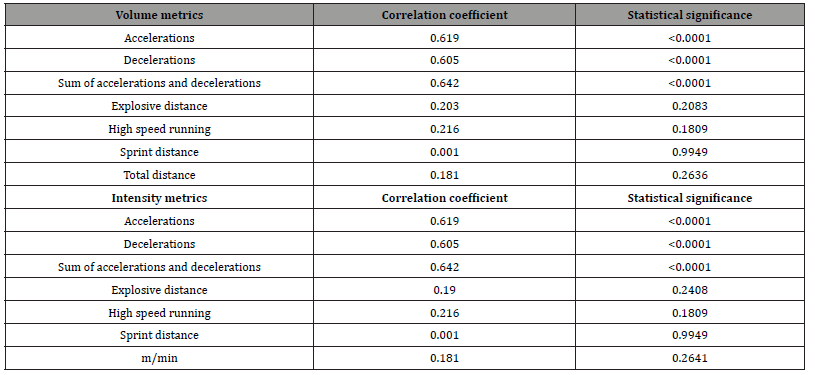
Table 4:Main characteristics of the 5v5 SSG test outcomes and match performance in terms of volume metrics broken down according to position.
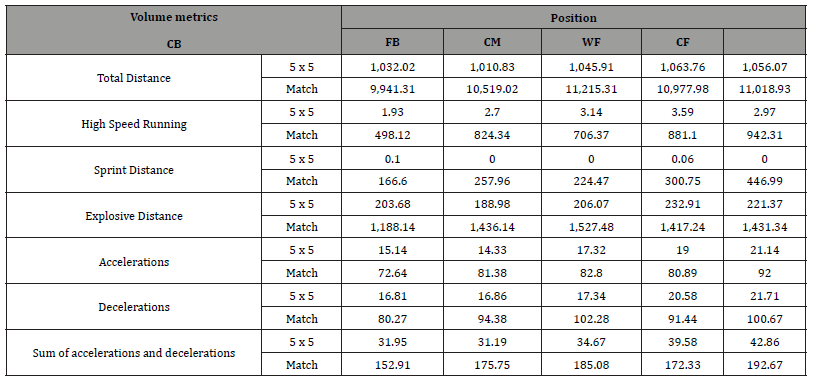
Table 5:Main characteristics of the 5 x 5 test outcomes and match performance in terms of intensity metrics broken down according to position.
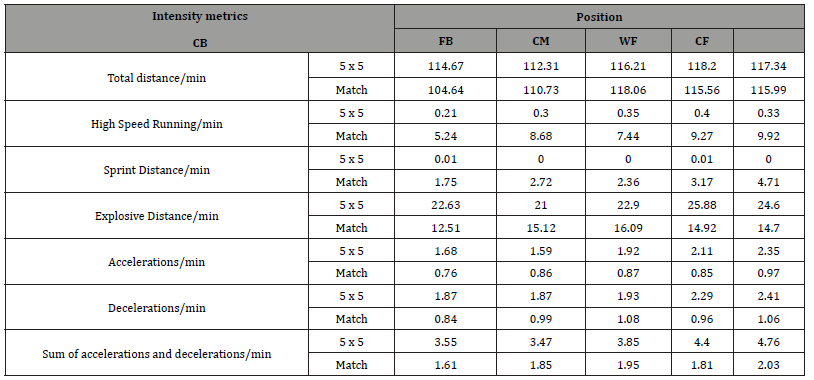
Table 6:Correlations between 5v5 SSG test outcomes and match performance in terms of volume and intensity metrics broken down according to position.
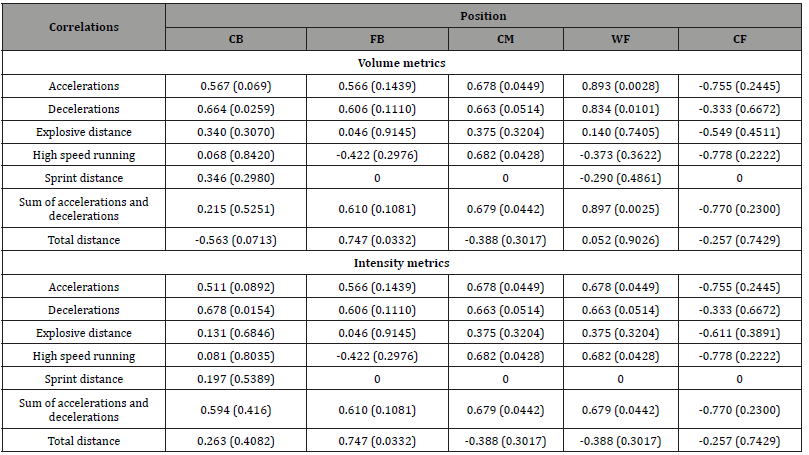
Discussion
The present study attempted to quantitatively assess the association between small-sided games and real-world match performances, with a focus on positional difference. Very little research has investigated this topic.
Lacome et al.’s research [22] was one of the first studies to address this issue and investigated the differences in player’s positional outputs across various SSG modalities (4v4, 6v6, 8v8, 10v10) in relation to their positional match demands. Lacome et al. [22] found that players only achieved relative running intensities to match-play (total distance per minute and high-speed running per minute) in the 10v10 SSGs and not in any of the other formats. While, in the 4v4 SSG, the results showed that players were exposed to a greater than match-play intensity with regards to mechanical loading (acceleration and deceleration) [22].
A player’s playing position and tactical role has a significant impact upon their physical demands in games. Although the physical demands vary significantly team upon team, generally Wide Forwards (WFs) experience the greatest locomotor requirements in games, in terms of high-speed running and total distance, while Full Backs (FBs) have the highest sprinting demands [23,24]. On the other hand, Centre Midfielders (CMs) tend to cover the greatest overall total distance, though at lower speeds, and also experience high mechanical (acceleration and deceleration) demands [23,24]. Additionally, Centre Backs (CBs) generally have the lowest overall physiological demands in match-play [23,24]. Having an understanding of the positional physiological demands of soccer match-play is important when prescribing training content to ensure all players are exposed to the necessary physiological stimuli for adaptation [22].
In this regard, Lacome et al.’s study [22] uncovered significant physiological variability in the player’s outputs per position across various small to large SSGs. Lacome et al. [22] found that in the moderate to large SSGs (6v6 and 8v8), relative to their game demands, CMs were being underloaded from a mechanical perspective, while CBs attained greater relative total distance and high-speed running outputs than CMs in the 6v6 games. These results highlight the importance of analyzing the positional demands of SSGs to ensure players receive appropriate additional work to ensure they are not underprepared for their positional demands of match-play. Extensive research [12-16] has explored the physiological and technical demands of SSGs in elite-level soccer, and there has also been an increase in the analysis of the physical demands of SSGs in relation to the demands of match-play [8,9,22].
Additionally, research [10,20] has explored the use of SSGs to assess aerobic fitness in elite-level team sports. However, to the best of the author’s knowledge, very few studies, if any, have explored the relationships between maximal physiological outputs in SSG test protocols and in elite-level soccer match-play. Consequently, the primary aim of this study is to compare the locomotor and mechanical outputs of players in a standardized 5v5 SSG test protocol [10] in relation to their maximal outputs in elite-level soccer match-play. Additionally, this study also aimed to examine the positional differences between maximal physiological outputs in the 5v5 test protocol and in elite-level match-play. This research provides further insight into the applicability and effectiveness of soccer-specific performance testing protocols in elite-level soccer.
Conclusions
The present study found that, overall, accelerations, decelerations, sum of accelerations and decelerations resulted in large correlation coefficients, both in terms of volume and intensity metrics, between 5v5 SSG test outputs and real-world match performances. In terms of positional differences, accelerations and decelerations in terms of volume metrics correlated between 5v5 SSG test outcomes and match outputs with large correlation coefficients in CB, and CM players. Coefficients were very large in WF players. The sum of accelerations and decelerations resulted in statistically significant correlations with large and very large coefficients in CM and WF players, respectively. Total distance correlated with a very large correlation coefficients in FB players. Similar trends could be reported in terms of intensity metrics. Summarizing, the present study has found that running performance during a standardized 5v5 SSG within elite soccer cohorts is associated with maximal match outputs, with the strength of correlation coefficients significantly varying according to playing positions. Soccer specific SSG could potentially supplement traditional testing methodologies.
Author Contributions:
Conceptualization, A.L.O., M.N. and N.L.B.; methodology, A.L.O., M.N. and N.L.B.; software, A.L.O., M.N. and N.L.B.; validation, A.L.O., M.N. and N.L.B.; formal analysis, A.L.O., M.N. and N.L.B.; investigation, A.L.O., M.N. and N.L.B.; resources, A.L.O., M.N. and N.L.B.; data curation, A.L.O., M.N. and N.L.B.; writing-original draft preparation, A.L.O., M.N. and N.L.B.; writing-review and editing, A.L.O., M.N. and N.L.B.; visualization, A.L.O., M.N. and N.L.B.; supervision, A.L.O., M.N. and N.L.B.; project administration, A.L.O., M.N. and N.L.B.; funding acquisition, N.L.B. All authors have read and agreed to the published version of the manuscript.
Funding
This research received no external funding.
Acknowledgement
The authors would like to acknowledged the players effort and professionalism throughout the testing and monitoring phases of this study. The authors would also like to thank them for their involvement in the investigation.
Conflict of interest
No conflict of interest.
References
- Barnes C, Archer DT, Hogg B, Bush M, Bradley PS, et al. (2014) The evolution of physical and technical performance parameters in the English Premier League. Int J Sports Med 35(13): 1095-1100.
- Zhou C, Gómez MÁ, Lorenzo A (2020) The evolution of physical and technical performance parameters in the Chinese Soccer Super League. Biol Sport 37(2): 139-145.
- Northeast J, Russell M, Shearer D, Cook CJ, Kilduff LP, et al. (2019) Predictors of Linear and Multidirectional Acceleration in Elite Soccer Players. J Strength Cond Res 33(2): 514-522.
- Stølen T, Chamari K, Castagna C, Wisløff U (2005) Physiology of soccer: an update. Sports Med 35(6): 501-536.
- Faude O, Koch T, Meyer T (2012) Straight sprinting is the most frequent action in goal situations in professional football. J Sports Sci 30(7): 625-631.
- Casamichana D, Castellano J, Castagna C (2012) Comparing the physical demands of friendly matches and small-sided games in semiprofessional soccer players. J Strength Cond Res 26(3): 837-843.
- Casamichana D, Castellano J, Dellal A (2013) Influence of different training regimes on physical and physiological demands during small-sided soccer games: continuous vs. intermittent format. J Strength Cond Res 27(3): 690-697.
- Martin-Garcia A, Castellano J, Diaz AG, Cos F, Casamichana D, et al. (2019) Positional demands for various-sided games with goalkeepers according to the most demanding passages of match play in football. Biol Sport 36(2): 171-180.
- Martín-García A, Casamichana D, Díaz AG, Cos F, Gabbett TJ, et al. (2018) Positional Differences in the Most Demanding Passages of Play in Football Competition. J Sports Sci Med 17(4): 563-570.
- Owen AL, Newton M, Shovlin A, Malone S (2020) The Use of Small-Sided Games as an Aerobic Fitness Assessment Supplement Within Elite Level Professional Soccer. J Hum Kinet 71: 243-253.
- Hill-Haas SV, Dawson B, Impellizzeri FM, Coutts AJ (2011) Physiology of small-sided games training in football: a systematic review. Sports Med 41(3): 199-220.
- Rampinini E, Impellizzeri FM, Castagna C, Abt G, Chamari K, et al. (2007) Factors influencing physiological responses to small-sided soccer games. J Sports Sci 25(6): 659-666.
- Hill-Haas SV, Coutts AJ, Dawson BT, Rowsell GJ (2010) Time-motion characteristics and physiological responses of small-sided games in elite youth players: the influence of player number and rule changes. J Strength Cond Res 24(8): 2149-2156.
- Dellal A, Chamari K, Owen AL, Wong DP, Lago-Penas C, et al. (2011) Influence of technical instructions on the physiological and physical demands of small-sided soccer games. European Journal of Sport Science 11(5): 341-346.
- Kelly DM, Drust B (2009) The effect of pitch dimensions on heart rate responses and technical demands of small-sided soccer games in elite players. J Sci Med Sport 12(4): 475-479.
- Malone S, Hughes B, Collins K (2019) The Influence of Exercise-to-Rest Ratios on Physical and Physiological Performance During Hurling-Specific Small-Sided Games. J Strength Cond Res 33(1): 180-187.
- Köklü Y, Sert Ö, Alemdaroğlu U, Arslan Y (2015) Comparison of the physiological responses and time-motion characteristics of young soccer players in small-sided games: the effect of goalkeeper. J Strength Cond Res 29(4): 964-971.
- Fanchini M, Azzalin A, Castagna C, Schena F, McCall A, et al. (2011) Effect of bout duration on exercise intensity and technical performance of small-sided games in soccer. J Strength Cond Res 25(2): 453-458.
- Impellizzeri FM, Marcora SM, Castagna C, Reilly T, Sassi A, et al. (2006) Physiological and performance effects of generic versus specific aerobic training in soccer players. Int J Sports Med 27(6): 483-492.
- Stevens T, De Ruiter C, Jan Beek P, Savelsbergh G (2016) Validity and reliability of 6-a-side small-sided game locomotor performance in assessing physical fitness in football players. J Sports Sci 34(6): 527- 534.
- Grgic J, Oppici L, Mikulic P, Bangsbo J, Krustrup P, et al. (2019) Test-Retest Reliability of the Yo-Yo Test: A Systematic Review. Sports Med 49(10): 1547-1557.
- Lacome M, Simpson BM, Cholley Y, Lambert P, Buchheit M, et al. (2018) Small-Sided Games in Elite Soccer: Does One Size Fit All? Int J Sports Physiol Perform 13(5): 568-576.
- Mallo J, Mena E, Nevado F, Paredes V (2015) Physical Demands of Top-Class Soccer Friendly Matches in Relation to a Playing Position Using Global Positioning System Technology. J Hum Kinet 47: 179-188.
- Bush M, Barnes C, Archer DT, Hogg B, Bradley PS, et al. (2015) Evolution of match performance parameters for various playing positions in the English Premier League. Hum Mov Sci 39: 1-11.
-
Adam Lee Owen*, Matthew Newton and Nicola Luigi Bragazzi. Relationships Between the Physical Outputs of a Standardized 5v5 SSG Test Protocol and Maximal Match Outputs in Elite-Level Soccer. Aca J Spo Sci & Med. 1(4): 2024. AJSSM.MS.ID.000519.
-
Physical Outputs, SSG Test Protocol, Maximal Match Outputs, Elite-Level Soccer, 5v5 SSG, Yoyo IR2, Aerobic Capacity, Training, Accelerations and Decelerations
-

This work is licensed under a Creative Commons Attribution-NonCommercial 4.0 International License.
- Abstract
- Introduction
- Materials and Methods
- The Basic Tools of Scientific Inquiry
- Literature Review
- Theoretical Framework
- Research Design
- Findings and Discussion
- Conclusion and Recommendations
- Based on the findings, the following recommendations are considered:
- Declaration Statements
- Funding
- Data Availability Statement (DAS)
- Compliance with Ethical Standards
- Acknowledgement
- Conflict of Interest
- References






